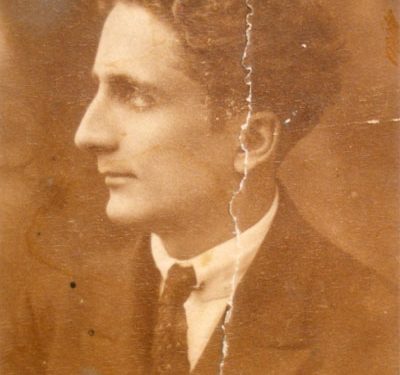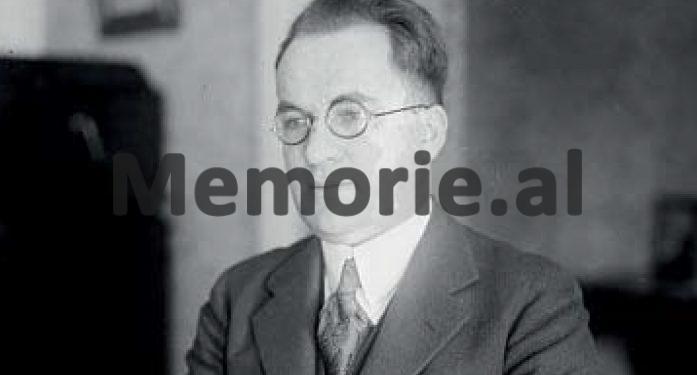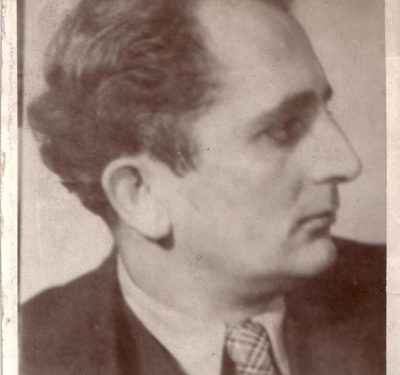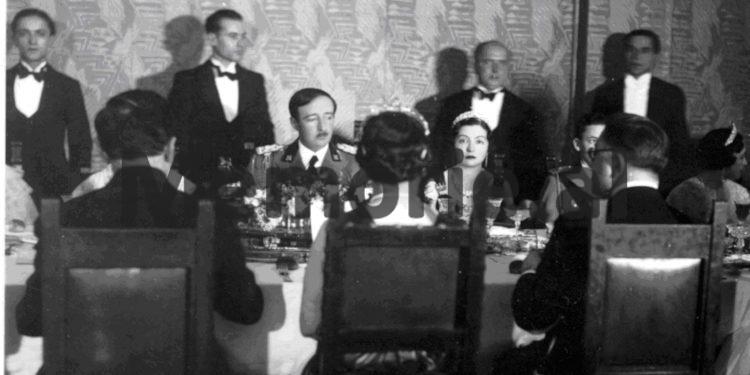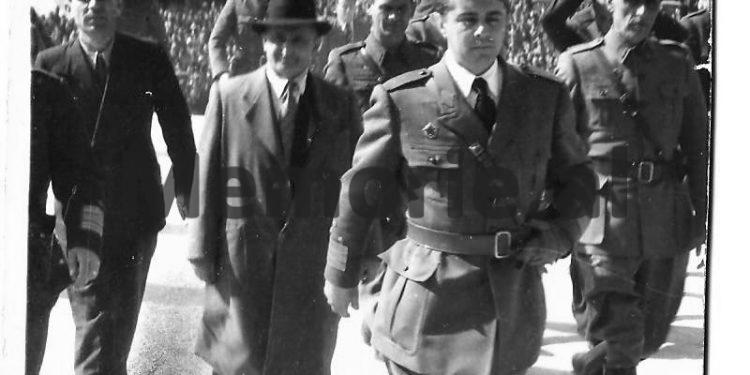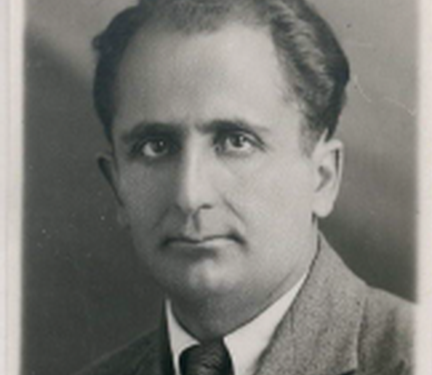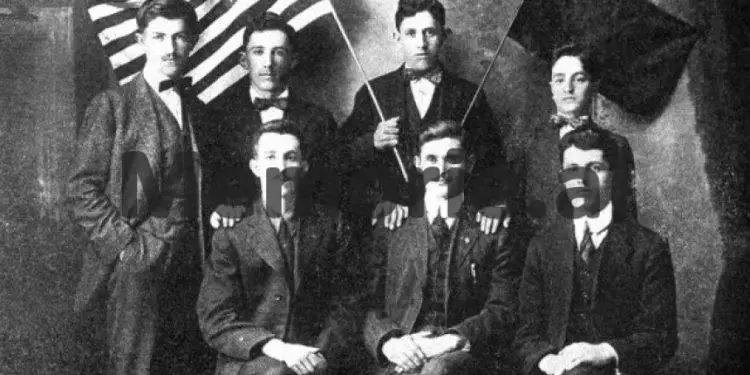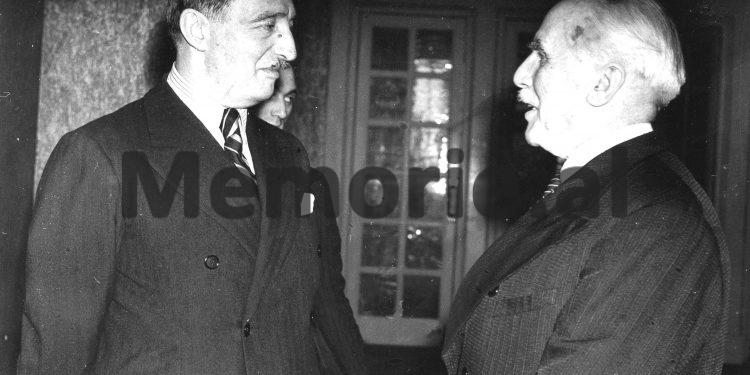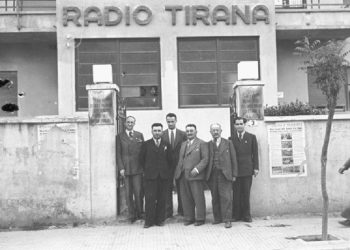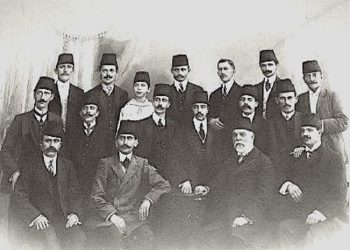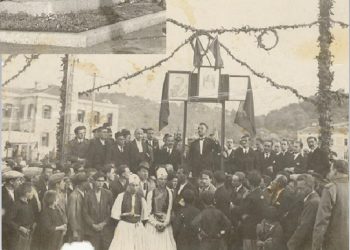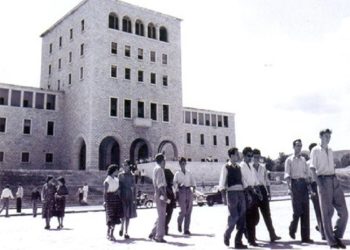Dashnor Kaloçi
Memorie.al publishes the unknown story of Kostë Çekrez, who after spending a lifetime between endless vicissitudes and sufferings, which, among other things, brought him to be away from his homeland and relatives there in foreign lands. from where he had left in 1935, when he had attempted and failed in an attempt to lead an armed uprising against King Zog, in addition to political activity for the benefit of the Albanian cause to which he had devoted himself for years, therefrom 1951, he decided to return once again to his first passion, journalism, and journalism. A profession he had practiced for more than three decades in his youth. Even running two or three of Albania’s most popular newspapers of those years and its diaspora in the United States, where unlike many of his colleagues who had compromised with the regime, he had struggled and fought for the right to speak and to remove her heavy “handcuffs”. Closed in his apartment, which was not more than three miles away from the White House, he ended up writing the book “Albania’s Third Partition Plan”, which analyzed all the events, vicissitudes, many dangers, and the invasions that Albania had gone through since the “establishment” of the first Albanian state in November 1912, wherein many of those events, if not the protagonist, he had been an eyewitness himself. (Subtitles are editorial)
After spending a lifetime between the vicissitudes and endless sufferings that, among other things, brought him to be away from home and relatives there and abroad, from where he had left in 1935, when he had tried and failed in his attempt to lead an armed uprising against King Zog, in addition to his political activity for the benefit of the Albanian cause to which he had devoted himself for years, from 1951, he decided to return once again to his passion. his first, journalism and journalism. A profession he had practiced for more than three decades in his youth. Even running two or three of Albania’s most popular newspapers of those years and its diaspora in the United States, where unlike many of his colleagues who had compromised with the regime, he had struggled and fought for the right to speak and to remove her heavy “handcuffs”. Closed in his apartment, which was not more than three miles away from the White House, he ended up writing the book “Albania’s Third Partition Plan”, which analyzed all the events, vicissitudes, many dangers, and the invasions that Albania had gone through since the “establishment” of the first Albanian state in November 1912, wherein many of those events, if not the protagonist, he had been an eyewitness himself. Given the fact that the book, which is almost unknown to Albanians, deals with, elaborates and analyzes in detail some of the most critical events and situations that Albania has gone through during the last century, (from the establishment of the Monarchy until the year 1951, when it was published in the US), we have selected for publication some parts of that book, giving them without any change from the original version used by their author.
follows from the previous number
Excerpts from the book “The third plan for the partition of Albania”
“The role of communists in the Fier Uprising”
According to reports, many times without a name, Zog’s Interior Ministers, especially the famous Musa Juka, a follower of every liberal and young man, ordered the arrest and imprisonment of forty young boys and students on charges of being “Bolsheviks”. In this way, opponents of Zog’s pro-fascist regime managed to conceal the Communist title. If one were to rely on the reports of the Ministry of the Interior, one would conclude that almost all the youth of the country worshiped Lenin and Stalin. The opposite test came to light on the occasion of the Fier Movement, in which I was called to play the main role. In my efforts to gather together and organize all the opposing elements of the regime, I also came in contact with the “Communist Group” of Albania. My surprise and that of my friends was great when the leaders of that group gave us the list of their members. The list contained exactly 73 (seventy-three), names. Most of them were non-commissioned officers (testers, captains, and sergeants), and the ay who held the highest rank was only a lieutenant. The others were primary school teachers who did not know where the rifle was coming from. But even those of the 73rd were not real communists, but melted idealists who thought that any problem in Albania would be solved automatically the minute the Soviet regime was put in place in our country. That they were not real communists is proved by the fact that when the real communists came to power, led by Enver Hoxha, the leaders of that original communist group were put on rifles and ropes, starting with the founder of the first “Communist Group. ”Of Albania, Zai Fundo (the real sower of the communist seed in Albania, Kostandin Boshnjaku, was shot in April 1945). And all this time, when Zog’s Interior Ministry was following in the footsteps of the Albanian youth as “Communists”, the expected chairman of the communist regime in Albania, Enver Hoxha, was studying in Europe with a scholarship given by the Zogist regime!… In this view Thus, it can be said that the Zog regime was preparing the square for the coming to power of the communist regime, pushing the country’s youth to seek a solution to Albania’s problems in establishing anti-nationalist Sovietism. But when it was known that young people were branded as “Communists”, they were not able to create any movement against the Zog regime, the work was quite different in terms of the “priority” of the country, which included beys, bayraktars and arhonds.. (In Korça the word “priority” was used to design (a mark or define) the most influential families within the Orthodox community; in Berat, that word was used to design the Vrionas family; in Vlora, the word “priority” was used to design rich “Croesus”. ; in northern Albania, the “primacy” of the country consisted of bayraktars of different tribes). These common “priorities” had long regretted the support they had given Zog when he returned to power in 1924, with the help of Yugoslavia and Greece, to overthrow the six-month regime of Monsignor Noli.
Korça Beylers: Let’s stop Zog
Only six months after Zog’s appointment as “President of the Republic”, “the first of the country”, they realized that the ambition of that man exceeded all limits. And they decided to set a limit before the work could go on. In a secret meeting held in Korça in July 1925, with the initiative of Myfid Bey Libohova, the means and ways to limit Zog’s power as President of the Republic were discussed. But, fortunately, the government of Tirana became aware of the meeting and its goals, and Zogu, acting with his usual speed in such cases, threw them out of the offices held by all the beys participating in the Korça meeting. Since then, the beys have taken an undeclared oppositional and secretive stance, for reasons that can be easily understood. The fact is that in the Fier Movement – which was organized about 10 years later – we had more Bejlers than soldiers in our ranks. The Vrionas of Berat were in the front line. And one of the reasons why Fier was chosen as the capital of the movement was that that small town was almost a fiefdom of the Vrionas. After the failure of the Fier Movement – a failure which was caused by the incompetence of some officers to make the right connections with the Northern Bajraktars – The country’s priority and not only the Beylers, reached the logical conclusion that: after Zog was held in power through the support it had from fascist Italy, the only way to get rid of it, was for them to be the first to make a direct agreement with the government of Rome. The mediators for this agreement were Shefqet Vërlaci and Mustafa Merlika of Kruja.
The Beys’ agreement with Rome against Zog in 1938
The agreement was signed in December 1938. Under it, the Roman government pledged to cease providing any support to Zog, so that “the country’s leaders” could be overthrown by their own means and not by any military intervention by the Italian government. For their part, the “first of the country” vowed to invite a cousin of the King of Italy, such as Duke d’Aosta, to the throne of Albania. (“King forking”, they said among themselves, Duke d’Aosta would make a better figure as king than “Maloku i Matit”). In this way the government of Rome had come to the conclusion that Zog was not a man who could trust him; and in that opinion were all those who had to do with the Malok of Mat. However, when the time came for that agreement to be implemented, the treacherous Duchess threw it at the “firsts” of our country. Instead of the principle of preserving Albanian independence under an Italian king, Mussolini had always aimed to occupy Albania, using “the country’s leaders” as tools. This is proved beyond any doubt by the clear notes of Count Ciano in His Diaries, published in English in 1946 by the publishing company Doubleday & Co. Count Ciano, Duchess’s son-in-law and his Minister of Foreign Affairs, leaves no doubt about this point when he writes that in agreements with Albanians opposed to Zog, the Duchess’s government had a single goal: to eradicate Albania’s independence in time. which provided full insurance to Shefqet Vërlac and Mustafa Kruja, that it would respect its independence. This dirty trick of the Duce was understood, even by those who had made the secret agreement with him. But they realized it too late. When, therefore, the government of Rome handed over to Zog on April 5 the ultimatum by which it demanded that the government of Tirana accept Italian troops in the ports of Vlora, Durres, and Saranda – among other conditions, Zog submitted to parliament the demands of the government of Rome. In a voice, parliament rejected Italy’s demands. Among those who voted “against” were those who had previously agreed to the Duce agreement. For once it seemed that the Albanian nation was completely united with its resistance against Italy. But here is what Count Ciano writes in his Diaries: “Throughout this time, Zog was doing his best to reach an agreement with the government of Rome. According to Ciano’s notes, Zog was ready to accept any request from Italy, provided he held the throne. However, Mussolini had decided to occupy Albania, and Zogu was no longer employed. The Duce, therefore, rejected any agreement with Zog. Instead, he ordered his troops gathered in Bari and Brindisi to descend on Albania’s scaffolding and 400 planes to fly over Tirana to terrorize its people. In such a difficult case, Zog made a gesture of bravery; ordered the army to attack the Italians. Some of his opponents want to say that Zog gave that order to gain time in his escape in the gloom of that tragic day for Albania. In any case, the Italians were convinced that Zog would not leave without a fight. Here is what Count Ciano writes on this point: “March 31, 1939. The news from Tirana confirms the fact that Zogu is making all the preparations for the opposition. I don’t like that at all, because it seems to me like a dangerous job for us to fire the first rifle in the already turbulent and heated situation in Europe. April 2, 1939. Our plan is to stop Zog’s escape to Mat, where he can organize the centenary against our powers. April 8, 1939. All our fears that Zog might be at war in the mountains of Albania were dispelled when we learned that he had run into Greece. Thus ended Zog’s role in Albania’s greatest tragedy of our day.
The leadership of Albania in the trap of the Duce
It is time now to return to the position of the “first of the country” who fell into the trap set by the Duce, remembering that they would be smarter than Mussolini. According to Count Ciano’s abundant notes on this point, there is no doubt that their remorse and despair were sincere. They felt the greatest shock when they heard from Chiano that the government of Rome had no intention of allowing an Italian prince to ascend the throne of Albania; on the contrary, the Duce had decided to eradicate all the independence of Albania, which would later become part of the Italian kingdom. Shefqet Bey Vërlaci was one of the first to protest, but those who most strongly opposed the Duchess’s decision were the Catholic leaders of Shkodra. See now how Count Ciano describes the ceremony of presenting the crown of Albania to the King of Italy, Victor Emmanuel III.
“The ceremony took place at the Royal Palace of Rome. Albanians look desperate. Vërlaci, in particular, seems more desperate than the others and barely utters the words of the presentation of the crown. “Albanians expected the king or Mussolini to give them a pledge to respect their country’s independence.” Their reception was in vain. The Beylers, Bajraktars, and Arhonds, who were once so arrogant, became the same apprentices of the Duce and Jakomon (the latter was appointed in Tirana as the successor to the king of Italy), and when Italy decided to fall to Greece on account of A few months later, Duçja also plunged Albania into war. It was this last act that prompted the British government to pledge to the Greeks that Korça and Gjinokastra would become theirs at the end of the war. And so the Third Coptic Plan of Albania came to an end.
Duce’s efforts to overthrow Zog
Let the impartial singers stand by now and think deeply about who should be most responsible for the series of disasters that befell this chapter. Let us now clarify one last point. I learned of the secret agreement between the Duchess and Shefqet Vërlac to overthrow Zog in Paris on the night of January 1, 1939, when Mustafa Merlika Kruja arrived in the French capital to persuade the Albanian refugees of the “National Union” to flee France. and to come to Italy, to be ready to take part in the overthrow of Zog ”. A few weeks later, Dr. arrived in Paris. Qemal Jusufati, General Director of the Albanian Red Cross. I reported the whole plan to him and begged him to return to Tirana without delay, to inform Zog about the fate that had been prepared in Rome, adding that his own salvation could come from a general union based on an amnesty. full and formation of a truly national government. To this day I do not know if Dr. Kemal brought my words to Zog. The fact is that Zog did nothing at this point.
The role of the political diaspora in helping the government of Tirana: “Albania in 1945, lost 40 million USD aid from the US”
In his book “The Third Plan of the Partition of Albania”, published in 1951 in the USA, the politician, and publicist Kostë Çekrezi, also focused on Albania’s relations with the USA at the end of the Second World War, as and the role of the Albanian political diaspora in America in helping the Albanian cause. Concerning this, among other things, Çekrezi wrote: “When I arrived in America I displayed my plan drawn up at the Vernet de l’Ariege worldwide on November 16, 1941, in front of a large majority that gathered at the Peabody Playhouse. , Boston Mass. After he was accepted with one voice – with the exception of a group of fanatics who stood up to leave the meeting room, as a sign of protest, at voting time, and the voice of a young man who asked me when I would to establish the regime of the people in Albania – I went to meet according to the order of the meeting with Monsignor Noli, to ask for his support. The bishop was strongly reserved for the reason that “he did not engage in politics.” So last night he advised me to get along with Faik Konica, about the role that “Vatra” could play in the implementation of my plan. With the follower Faik, I met in Washington a few days later in the former Albanian legation. On that occasion, Faik Konica openly told me that: “VATRA” could not change its policy, which was completely pre-Italian, and which was left at that time in the hands of another deceased, who had none. political ability, Vasil Panit. Apart from that, Faik Konica left me with no doubt that he was, of course, completely against the idea of building a new organization in America. When I was separated from the former Minister of Zog, a wise saying used in Northern Albania came to my mind: “If you want to do some useful work, go and ask your opponent and do the opposite of what you do. advises ay ”. It was in these conditions that the democratic organization of “Fre Albania” was raised generously and worldwide in Boston on December 28, 1941. Its specific program was: Cooperation with the Allies and especially with the United States government. Following this policy, the organization entered into close cooperation with various US government agencies. Through the Office of War Information (OWI, Office of War Information), “Free Albania” quickly became one of the nations oppressed by Nazi-fascists to take advantage of the facilities provided by the Washington government to addressed their peoples across the ocean speeches and radio calls. Through the Office of Strategic Services (OSS, Office Strategic Services), we of “Free Albania” paved the way for the secret entry into Albania of dozens of Albanian and Albanian-American agents who came into contact with the Liberation War Forces. which the “Sun” at the time called “rebels” against Italy, meaning that the government set up in Albania by fascist Italy was the only legal force of the Albanian State. And within the State Department, “Free Albania” created a wide circle of friends and supporters of Albania’s independence who caused the department to publish in its favor some statements of international importance, such as that of 10 December 1942 and November 28, 1944. And in May 1945, one by one after the end of the war in Europe, the State Department sent a diplomatic mission to Albania under the chairmanship of Minister Josep R Jakobs (later US Ambassador to the Czech Republic and Korea)… For the sake of truth, it must be said that sending this mission was a very extraordinary step, and I am proud that I became the reason for its launch in Albania. As I will explain in the following pages, the mission failed in a shameful and scandalous way. To all this, it can be added – which has not been published so far – that “Free Albania” was in agreement with the competent offices to provide the Albanian government with a grant of 40,000,000 USD, for the reorganization of the state of newborn Albanian, in addition to other assistance that our people would receive and was receiving from the organization UNRRA, as well as from the International Red Cross. What should be especially emphasized is that all these benefits were provided to Albania without any interference or Anglo-American turmoil in its internal affairs, as far as I know, and from what the State Department officials with whom I worked closely at the time know. , whatever may have been published in the meantime by the Propaganda Office of the Tirana government. On the contrary, our efforts were aimed at eliminating any interference, English, Greek, or Yugoslav. Also, these benefits were provided to Albania when “VATRA” fought fiercely against “Free Albania”. In fact, in order to prevent the actions of the new democratic organization, “VATRA” once again grabbed the flag of the Monarchy, declaring through “DIELL” that: ” “Albania cannot be made without the Ahmet Zogu”./Memorie.al




